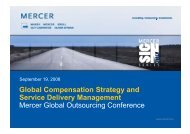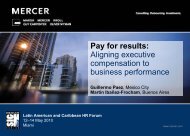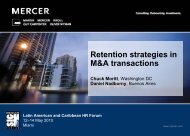A SERIES OF ARTICLES FRoM THE 2011 EMEA CoMPENSATIoN ...
A SERIES OF ARTICLES FRoM THE 2011 EMEA CoMPENSATIoN ...
A SERIES OF ARTICLES FRoM THE 2011 EMEA CoMPENSATIoN ...
You also want an ePaper? Increase the reach of your titles
YUMPU automatically turns print PDFs into web optimized ePapers that Google loves.
“The highest-performing men and women receive<br />
nearly double the bonus opportunity that they did four<br />
years ago”, says Penvern. “But in order to realise that<br />
bonus opportunity, they need to run as fast as they can<br />
in order to keep up with or stay ahead of the pack and<br />
the market”.<br />
While Penvern cites the value the company creates<br />
in this performance culture, he believes that the<br />
transparency of its bonus system is just as important.<br />
<strong>THE</strong> LINK BETWEEN PAY FOR PERFORMANCE<br />
AND ENGAGEMENT<br />
“We used to have discretionary bonuses but found<br />
with those that the correlation between pay and<br />
performance was almost zero – surprisingly”, he recalls.<br />
“This was a huge problem, as we know that the lower<br />
the link between pay and performance, and the less<br />
people can see this link, the worse our employee<br />
engagement becomes.<br />
“We also know that engagement predicts individual<br />
performance, team performance and customer<br />
satisfaction – the higher the first, the higher the<br />
other three. These factors are also linked to the<br />
leader’s performance – as his or her performance<br />
improves, this drives up the average performance<br />
score within the team. External research also shows<br />
that engagement predicts performance, customer<br />
satisfaction and financial results much more strongly<br />
than the other way around”.<br />
MEASURING SUCCESS<br />
So, engagement is critically important to performance<br />
and to bottom-line results, and a major factor in<br />
driving engagement is pay for performance – and,<br />
specifically, people’s belief that there is a link between<br />
how they perform and how they are rewarded.<br />
Penvern notes this is the real measure of the success<br />
of the drive towards pay-for-performance. The<br />
number of A.P. Moller–Maersk employees who agreed<br />
with the employee engagement survey statement<br />
“I believe that my pay and performance are linked”,<br />
rose from 45% in 2008 to 57% in <strong>2011</strong>, aligning A.P.<br />
Moller–Maersk with the top 25% of companies that<br />
use this as a criterion of engagement.<br />
This proportion rises to 80% amongst employees<br />
in the head office, where schemes for executives,<br />
directors and professional staff are fully embedded.<br />
Not surprisingly, the company is now looking to roll<br />
out pay-for-performance schemes across the majority<br />
of its businesses around the world, where it makes<br />
business sense.<br />
The lesson is clear. You build employee engagement<br />
and drive performance both by having a clear and<br />
transparent scheme that links pay and performance<br />
and by communicating this consistently in order to<br />
reinforce the belief that pay and performance are<br />
linked. It’s critical to walk the talk, and if you succeed,<br />
it is, as Penvern concludes“ a virtuous circle”.<br />
Alex Penvern is A.P Moeller–Maersk Group’s Global Head of Compensation, Rewards and Executive HR. Based in<br />
Copenhagen, he can be contacted at alex.penvern@maersk.com<br />
31<br />
29
















